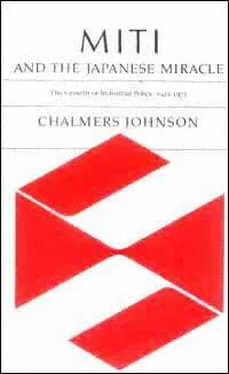Special accounts

195

274

341

431

569

716

587

651

986

(5)

(7)

(8)

(6)

(7)

(8)

(5)

(4)

(6)

SUBTOTAL
1,481
1,303
1,364
1,595
2,131
2,314
2,606
2,856
3,697

(38)

(34)

(31)

(23)

(27)

(24)

(23)

(19)

(20)

TOTAL
3,937
3,835
4,420
6,896
8,040
9,468
11,547
15,132
18,036
(100)
(100)
(100)
(100)
(100)
(100)
(100)
(100)
(100)
SOURCE
: Endo * Shokichi*,
Zaisei
toyushi
* (Fiscal investment and loan funds), Tokyo, 1966, p. 149.
Page 213
early years was the International Trade Bureau, the successor to the old Board of Trade. But the fact that the bureau's chief and most of its senior officials were diplomats marking time until foreign relations were restored inevitably meant that the bureau was known as a ''branch store of the Foreign Office" (
Gaimu-sho
*
no demise
)and was deeply resented as such by the veterans of the Kishi-Shiina era. This was also MITI's "dark age," when the position of chief secretary was occupied by Nagayama Tokio, who had been placed in office by Yoshida's personal adviser, Shirasu Jiro*.
29
The first order of business for the new vice-minister, Yamamoto Takayuki, was to try to restore the morale of the industrial policy bureaucrats and to deal with the factional problems created by Nagayama's presence. Two situations aided him in these endeavors: Dodge's balanced budget policy had dictated a major reduction in the numbers of government officials, and SCAP after the outbreak of the Korean War had turned its purge directives against communists, who as a practical matter were primarily trade union leaders. MITI possessed a very vigorous unionZenshoko* (All Commerce and Industry Workers' Union), an affiliate of the radical Kankoro* (Federation of Government and Public Workers' Unions)that regularly took actions that provided suitable pretexts for letting people go. For example, in April 1950 Zenshoko blocked the car and later barricaded the office of Takase Sotaro* (the former president and great "senior" of the Tokyo University of Commerce, renamed Hitotsubashi University in May 1949), who had just come to MITI as minister while serving concurrently as minister of education.
30
On the basis of direct orders from the cabinet to cut the size of the bureaucracy, Yamamoto used incidents such as this to fire about 10,000 officials between 1949 and 1951. The staff of MITI's internal bureaus fell from 13,822 in 1949 to 3,257 in 1952.
31
This was surely one of the most salutary consequences of Dodge's deflation; MITI became a much leaner and more cohesive organization than the postwar MCI had ever been.
On the factional front Yamamoto appointed Ishihara Takeo as chief of the Enterprises Bureau, Tokunaga Hisatsugu as chief of the Mining Bureau, Hirai Tomisaburo* as chief of the Trade Promotion Bureau, and Tamaki Keizo* as chief of the Machinery Bureau. All were experienced cadres from the Kishi-Shiina era and all became vice-ministers during the 1950's. When Yamamoto resigned in March 1952, he passed on the vice-ministership to Tamaki. Nagayama, meanwhile, named most of the other bureau and section chiefs; and one of his notable successes was to remove Sahashi Shigeru, a rising young "control bureaucrat" and later vice-minister, from the critically impor-
Page 214
tant post of chief of the Cotton Textiles Section in the Textiles Bureau (which he held from December 1948 to August 1951) to a mere outpost as chief of the General Affairs Department of the Sendai regional bureau (August 1951 to August 1952).
During the period of rapid unionization in the early years of the occupation, Sahashi had been elected the first chairman of Zenshoko *, and although he was not a communist, this put him in an exposed position when the "red purge" began. In the course of the Dodge Line reduction in force, members of Zenshoko one day seized Chief Secretary Nagayama and subjected him to a kangaroo court. Although he was no longer a union leader, Section Chief Sahashi was summoned to mediate the dispute. In his typically outspoken manner (of which we shall have several examples in the next chapter), Sahashi ended the incident by loudly haranguing the workers that they would not save their jobs by pressuring a fool such as Nagayama. Shortly thereafter Sahashi found himself on a train heading northeast.
32
The objections to Nagayama were not just that he was serving as an agent of Yoshida and Shirasu but also that as chief secretary he had jumped over several other officials in the seniority hierarchy. It was during this period of poverty and firings that seniority became entrenched in all Japanese organizations as a vital source of job security. Nagayama's use of his political connections was thus seen as a potential threat to everyone. He was not, however, easy to dislodge. Tamaki, as vice-minister, worked on the problem, and he gained the support of his minister, Ikeda. When Ikeda had to resign after his "slip of the tongue" in the Diet about his not caring if a few small businessmen were driven to suicide, he advised his successor, Ogasawara Sankuro*, that Nagayama must go. At this same time Nagayama's position was weakened because his mentor, Shirasu, publicly criticized Prime Minister Yoshida and promptly lost his own influence.
Читать дальше













